The meaning of the movie The Great Gatsby
Each frame of “The Great Gatsby” dazzles with the sparkle of jewelry, shining smiles of gorgeous women, an atmosphere of incredible, inexhaustible wealth. Behind the spots of bright, as if on a New Year’s card, colors, behind the frantic rhythm of the chase and the juicy soundtrack, the undisputed star of which was Lana Del Rey, for some viewers the meaning was lost. For those wishing to clarify for themselves the essence of The Great Gatsby, we invite you on a guided tour of the historical background, symbols and motives of this film masterpiece, as well as the novel that underlies it.
The historical and cultural background of the events of the film and novel “The Great Gatsby”
America of the twenties. Just now – in 1918 – the First World War ended, and yesterday’s young fighters today are looking for their place in the tumultuous life of megacities. From the pre-war era, this generation inherited the concept of the “American Dream” – dreams of personal happiness and success, wealth and prosperity. But if earlier success was inextricably linked with work, efforts, now the American dream has acquired a completely different shade. After the introduction of Prohibition, a new way to make money appeared – underground trade (it was on this that Jay Gatsby made his fortune). This kind of new rich – somehow connected with crime – in the post-war years compete with aristocrats like the Buchanan couple in ways to spend money. The twenties is a real boom in consumption, time, when huge sums of money were spent on completely unnecessary things and entertainment. In the film, we see that the Buchanans, the Gatsby, and all the other wealthy inhabitants of New York spend their fortunes in whatever way.
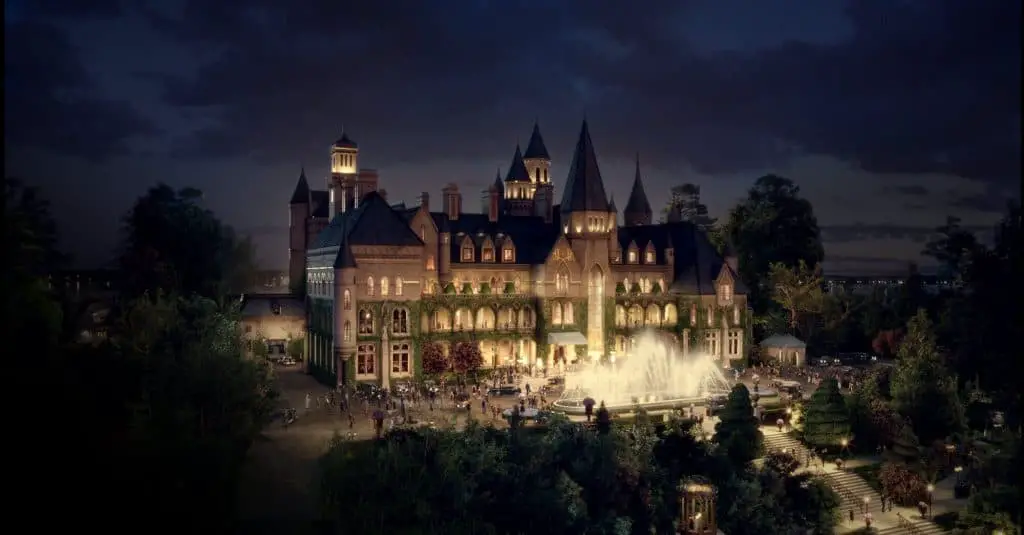
The castle where Jay Gatsby lives testifies to the latter’s lack of a sense of proportion
A significant detail in the novel and in the film is the place where the heroes live. The East Egg, which houses the Buchanan mansion, is the home of the aristocracy, wealthy noble families. These people are proud not only of their condition, but also of their origin. In contrast, West Egg’s inhabitants are those who became rich at lightning speed after the war, people like Gatsby and his brethren. If we compare the furnishings in the Buchanan house and the Gatsby castle, it becomes obvious that the representatives of the nobility are inherent in taste: the interior, clothing, decorations, garden – everything that belongs to the Buchanans is refined, elegant. On the contrary, Jay Gatsby sometimes does not know a sense of proportion – he throws parties incredible in their wastefulness, buys a mountain of expensive clothes, orders a flashy car, and sprinkles the whole house of Nick with fresh flowers to meet Daisy. The aristocracy has a delicate taste; Gatsby does not have it – this is the conclusion, but there is another opposition here: Gatsby has a big heart, while aristocrats are heartless. Jay spends the night under Daisy’s window, ready to protect her from Tom; worries like a schoolboy in her presence; ready to sacrifice all his wealth and success for her happiness. Daisy doesn’t even bother to attend his funeral.
Daisy and the American Dream in The Great Gatsby
Let’s go back to the theme of the American Dream – this is one of the main components of the meaning of The Great Gatsby. So people no longer strive for personal success; now they only want to make money, spend it and consume it. But as it turns out, that doesn’t make them happy. The main characters of the film – apart from the narrator, Nick Carraway – have everything that is included in the concept of the American Dream. Tom has a wife of unearthly beauty, wealth and noble birth. But happy, is he satisfied? Not; Daisy alone is not enough for him, and although he enjoys her company in public and has strong possessive feelings towards her, the company of the lower class representative Myrtle Wilson is much closer to him. Daisy at the very beginning of the film confesses to Nick that her life is boring and joyless: her husband does not love her, she knows very well about his mistress, She is not interested in raising her own daughter – but outwardly all the attributes of the owner of the American dream are evident: a rich husband, a beautiful house, luxurious outfits. Finally, Gatsby – he achieved everything himself, he has a whole castle at his disposal, he throws parties for the whole of New York. But for complete happiness he lacks Daisy, and he is also unhappy, like her, like Tom Buchanan.
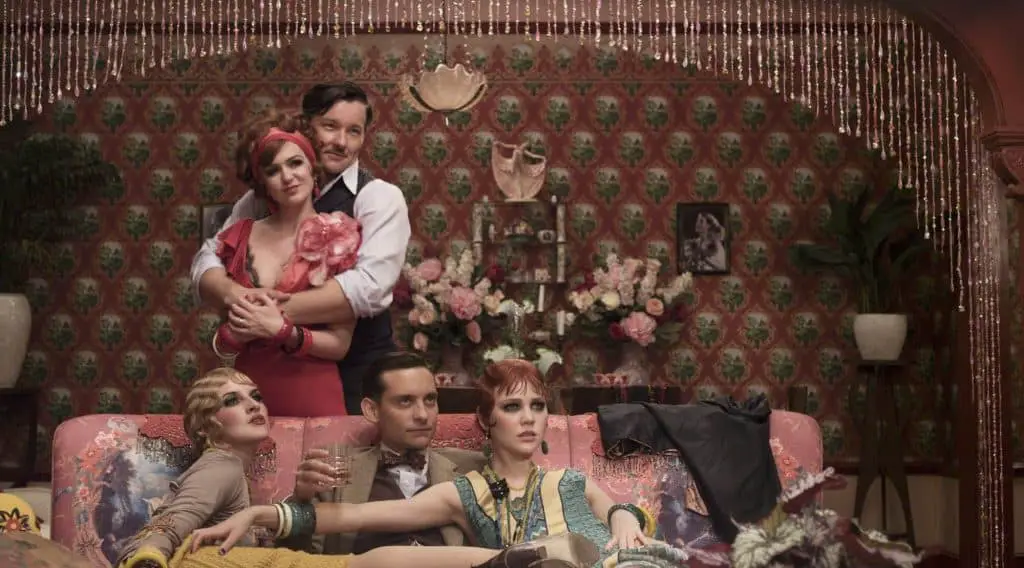
For Gatsby, the American Dream is Daisy Buchanan. For Tom Buchanan – crazy drinking with his lady of the heart – Myrtle
But it’s worth taking a closer look at Jay Gatsby’s feelings for Daisy Buchanan. Why is he trying so hard to be reunited with her? At first, Daisy’s character is unclear to the viewer; Gatsby’s imagination paints her as the most beautiful, most flawless girl. However, the closer you get to the denouement, the clearer the fact that Daisy does not at all deserve such a characterization. She is empty, reckless, her passion for Gatsby has long outlived, and now feeds only on the boredom of her current marriage. But for Gatsby, she herself is the living embodiment of the American dream. While someone is chasing wealth for consumption, Gatsby makes money for Daisy. He longs to put all his treasures at her feet – this is the only way to conquer her. But upon learning of his origin, Daisy begins to hesitate, and she lacks the courage to leave Tom. Daisy – the girl of dreams – turns out to be too empty and petty for a man of such a wide soul as Gatsby. And at the same time, America, the land of dreams, falls short of the expectations of those chasing the American dream. This is how Jay Gatsby’s tragedy reflects the frustration of an entire generation of Americans.
The Role of Details in Revealing the Meaning of The Great Gatsby
Throughout the film, many details, seemingly insignificant at first, take on additional meaning and help clarify the essence of The Great Gatsby. We will not be able to cover the full depth of these images in one article, but we will try to mention the most important ones.
Weather
The weather in The Great Gatsby is not just a background, but a significant detail that sets a certain tone for the events taking place. Recall that on the day of Gatsby and Daisy’s first date, it rained heavily over Long Island. The rain symbolizes despair, the loss of hope, and Gatsby really lost faith in the fact that Daisy would even show up for the meeting. However, during their meeting, the downpour stops and the sun comes out – a metaphor for renewal, the awakening of love.
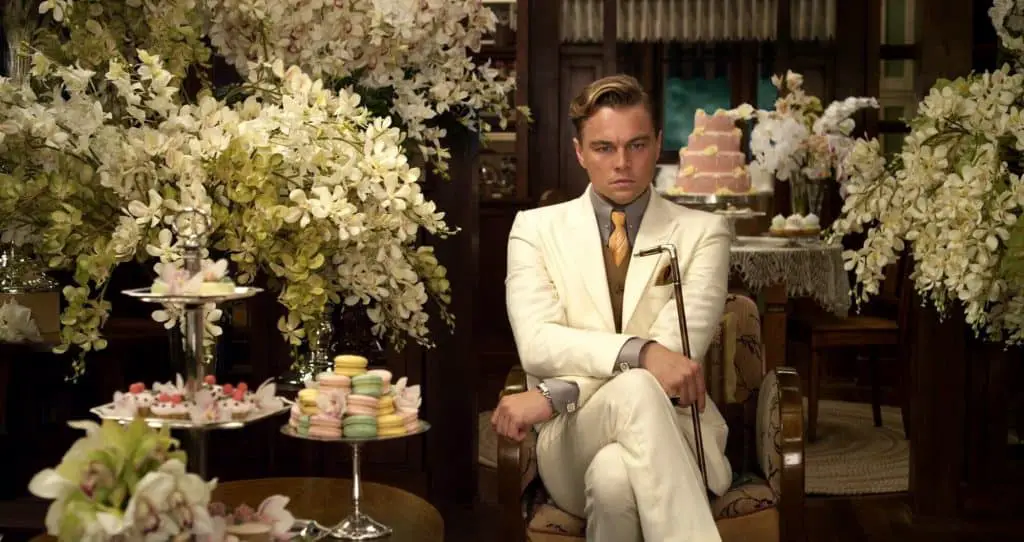
Gatsby prepares with boyish excitement to date Daisy after five years apart
Another important, emotionally charged moment in the film – the confrontation between Gatsby and Tom at the Buchanan house – takes place on an incredibly hot day. The directorial work here is amazing – how skillfully, with the help of colors, intonations, sounds, the unbearable atmosphere of a hot, sultry day is conveyed! And in this heat the passions of the heroes are heating up, a quarrel occurs, during which Gatsby loses his self-control. Finally, in the finale of The Great Gatsby, the weather sets the tone again: Wilson kills Jay on the first day of fall, when yellow leaves are strewn across the cold pool. Autumn is the time of withering, for Gatsby it literally means death, for Daisy – the death of their love affair, for Nick – the loss of a loved one, the only one he loved.
Telephone
Phone calls haunt the heroes from the very first to the last frames. The way each of them uses the phone characterizes the characters in a certain way. The phone rings in the Buchanan house anxiously and gloomily during Nick’s visit – Daisy knows that Tom is being called by his mistress, Myrtle. The phone in the Gatsby mansion is used in a completely different way: he is called to the phone only on business, but we know that these cases are of a criminal nature. Finally, the image of a telephone call is most powerful in the finale of The Great Gatsby. Jay is waiting for a call from Daisy, he is so sure that she will call that he orders to take the phone outside so as not to miss her call. However, instead of Daisy, Nick calls him – the only one who is truly worried about the fate of Gatsby. But Gatsby himself will never know – indirectly, the phone call that lured him out of the pool,
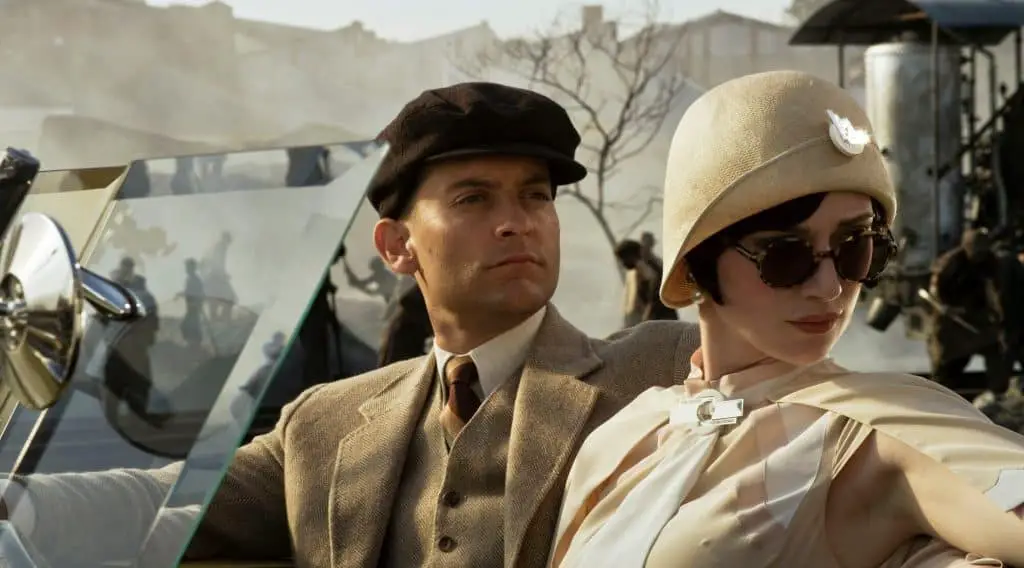
Nick Carraway is a silent witness to most of the events in the film and the only one who finds meaning and satisfaction from his own existence in the finale
Green light
“Gatsby believed in the green light …” says Nick Carraway. The green lantern on Buchanan Pier is a symbol of the dream, the fruitless hope that Gatsby was chasing. This is another reflection of the American dream – so beautiful, but distant, alluring, but empty inside. In one of the frames, Jay Gatsby reaches out with his hand to a light that flickers in the distance, on the other side of the bay. And in the final shots, remembering Gatsby, Nick again sees him watching the light of the green lantern. This inner unkillable hope became the core of Gatsby’s character, and because of her incredible strength, Nick was imbued with such respect for him.
Dr. Eckleberg’s eyes
The ominous look from under Dr.Eckleberg’s glasses on a half-erased advertising poster is a very powerful, but at the same time completely empty symbol. This look is compared to the eyes of a god who is watching what is happening on earth. However, in The Great Gatsby, Fitzgerald makes it clear that this symbol has meaning only insofar as it is filled with meaning by the people themselves. Thus, the doctor’s eyes are a symbol of emptiness and meaninglessness of everything around him. In the same way, other places, objects and people have meaning only because someone fills them with meaning. The American Dream is only meaningful to those who believe in it. New York is a city of hope and success for Nick only until he loses his faith in people. Daisy is the perfect girlfriend for Gatsby only because he himself made her so in his dreams.
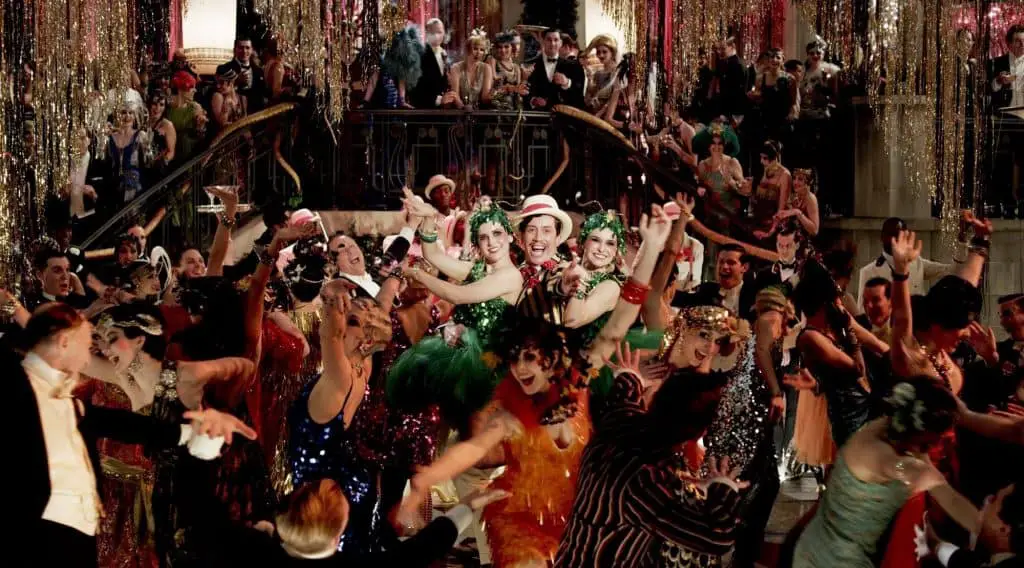
Crazy parties at the Gatsby house vividly reflect the atmosphere of America in the twenties
The meaning of the ending of the movie “The Great Gatsby”
It’s time to take stock. The Great Gatsby is a film about hopes and dreams, most of them failing. This is a film about people with ghostly goals. Those heroes who were chasing wealth and idleness – Tom and Daisy – were left unhappy. Gatsby, who made the love of Daisy, a narrow-minded and empty girl, the meaning of his life, found his doom. By bitter irony, Gatsby was ruined by his nobility – he took over the murder of Myrtle, although Daisy was driving the car. But Tom and Daisy were saved by their cowardice – Tom made Wilson believe that it was Gatsby who was Myrtle’s lover, while Daisy obediently hid behind Tom’s back.
The only person whose life purpose was not related to material values is Nick Carraway. He wanted to become a writer, but then foreign, external values led him astray. In pursuit of wealth, he parted with his dream, carried away by the luxury and idle life of New York. However, here, too, he found something that put him above the crowd of idlers around him – a friendship with Gatsby, absolutely disinterested and based on sincere respect. After the death of Gatsby, Nick for a long time could not recover and again find the lost meaning of his existence. But in the finale, we see that Nick is finishing a novel dedicated to his deceased friend. Thus, the only person whose goals were higher, broader than material acquisitions, was able to realize himself – he became a writer and told the world about who admired him so much – The Great Gatsby.







